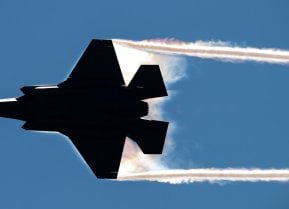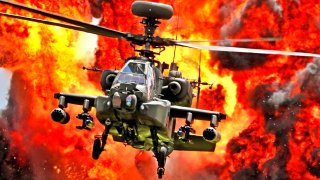AH-64 Apache: Nothing Can Stop America’s Best Attack Helicopter Ever
The 1990 film Fire Birds, starring Nicholas Cage and Tommy Lee Jones, may have missed the mark as a Top Gun-like blockbuster, but it successfully showcased the U.S. Army's AH-64 Apache, a helicopter that has since become synonymous with American air power.
What a Weapon: The 1990 film Fire Birds, starring Nicholas Cage and Tommy Lee Jones, may have missed the mark as a Top Gun-like blockbuster, but it successfully showcased the U.S. Army's AH-64 Apache, a helicopter that has since become synonymous with American air power.
How It Was Born: Born from lessons learned in the Vietnam War, the Apache was designed for close air support and anti-armor missions. Equipped with advanced systems and formidable firepower, including Hellfire missiles and a 30mm chain gun, the AH-64 has proven its versatility and lethality in various conflicts.
Key Point: Today, it's a key asset for the U.S. and allied militaries worldwide.
In 1990, one of the best bad movies of the age was made. Fire Birds starred a young Nicholas Cage (before his “Not the bees!” days), a slightly less old Tommy Lee Jones, and the actress from the original Ace Ventura film.
What made this film, which has been described as utterly “forgettable,” so great was its portrayal of the U.S. Army’s newest attack helicopter at that time, the AH-64 Apache. The film followed the quest of Cage’s young Army helicopter pilot to become a top ace Apache pilot.
Firebirds was clearly an attempt to capture some of the high-flying magic of the 1986 classic Top Gun, but it missed the mark for multiple reasons (namely because the culture had moved to a much different place just a few years after Top Gun was released). Nevertheless, its portrayal of the radical new Army helicopter made it worth watching. In fact, the Apache has become the most popular – and lethal – attack helicopter in the Army’s arsenal.
Indeed, many consider the AH-64 Apache the most lethal attack helicopter of all time.
Origins Story
The Army’s development of the AH-64 Apache finds its roots in the various failures of U.S. systems in the Vietnam War. Around this time, the entire U.S. military was forced to go back to the drawing board. In terms of strategy, the military was dead-set on avoiding another Vietnam, so it began to refocus its attention on preparing for a great power conflict with the Soviet Union in Europe.
Meanwhile, it began adapting new technologies and platforms to both meet its new mission of deterring a Red Army run on Europe via the Fulda Gap, as well as to address the aforementioned failures of certain U.S. systems in Vietnam.
There was a fixation on close air support (CAS) capabilities, and on using those abilities to obliterate armored targets on the battlefield (again, with the Red Army in mind). The Air Force was working feverishly on its now-legendary A-10 Warthog warplane. The Marines were building their new warplane that was capable of Vertical Take-Off and Landing, the Harrier jumpjet. But the Army, while needing a CAS capability, was forbidden from developing fixed-wing aircraft. Thus, the Army looked to its experience in Vietnam with helicopters.
Specifically, the service wanted to take the Cobra attack helicopter concept that worked so well in Vietnam and build a new attack chopper with increased firepower, range, ceiling, and anti-armor capacities. The AH-64 was born.
Too bad for the Army (but great for humanity) that the great Battle of the Fulda Gap between the Red Army and NATO never occurred. Instead, the Apache would be used to wage the conflicts of the post-Cold War era. The helicopter adapted well to the very same kind of counterinsurgency and counterterrorism wars in the Middle East that Army planners had hoped to avoid after the defeat in the Vietnam War.
Capabilities of AH-64
The AH-64 was meant to fly low to the ground and hide whenever possible to avoid hostile radar detection, and to dodge heat-seeking missiles by lowering its infrared signature, or the amount of heat it emits. Apaches come equipped with a potent 30 mm M230 chain gun that fires 625 rounds per minute. It can carry 16 Hellfire missiles and 76 Hydra rockets.
It is designed to withstand frontline conditions and operate at any hour – as well as in any weather condition. With systems such as the Target Acquisition and Designation System, Pilot Night Vision System, passive infrared countermeasures, GPS navigation features, and the Integrated Helmet and Display Sighting System, the AH-64 is a natural born killer, anywhere and at any time.
Built by Boeing, Apaches can travel upwards of 279 miles. They have a service ceiling of about 20,000 feet and a maximum operating weight of 23,000 pounds. Boeing’s website boasts that the total Army Apache flight hours (for all variants) is more than 5 million, and the total combat hours is more than 1.3 million. Between 1984 and 1997, Boeing produced 937 AH-64A Apache models, with some continuing to serve today. The most recent variant is the AH-64E.
The Apache is also one of America’s favorite military exports. The armies of Egypt, Greece, Israel, Japan, the Netherlands, Saudi Arabia, Singapore, the United Arab Emirates, and the United Kingdom all operate these systems. Its technological capabilities, versatility, and survivability combine to make it a highly attractive commodity.
Author Experience and Expertise: Brandon J. Weichert
Brandon J. Weichert, a National Interest national security analyst, is a former Congressional staffer and geopolitical analyst who is a contributor at The Washington Times, the Asia Times, and The-Pipeline. He is the author of Winning Space: How America Remains a Superpower, Biohacked: China’s Race to Control Life, and The Shadow War: Iran’s Quest for Supremacy. His next book, A Disaster of Our Own Making: How the West Lost Ukraine, is due October 22 from Encounter Books. Weichert can be followed via Twitter @WeTheBrandon.
All images are Creative Commons or Shutterstock.
From the Vault
Russia Freaked Out: Why the U.S. Navy 'Unretired' the Iowa-Class Battleships
Battleship vs. Battlecruiser: Iowa-Class vs. Russia's Kirov-Class (Who Wins?)


